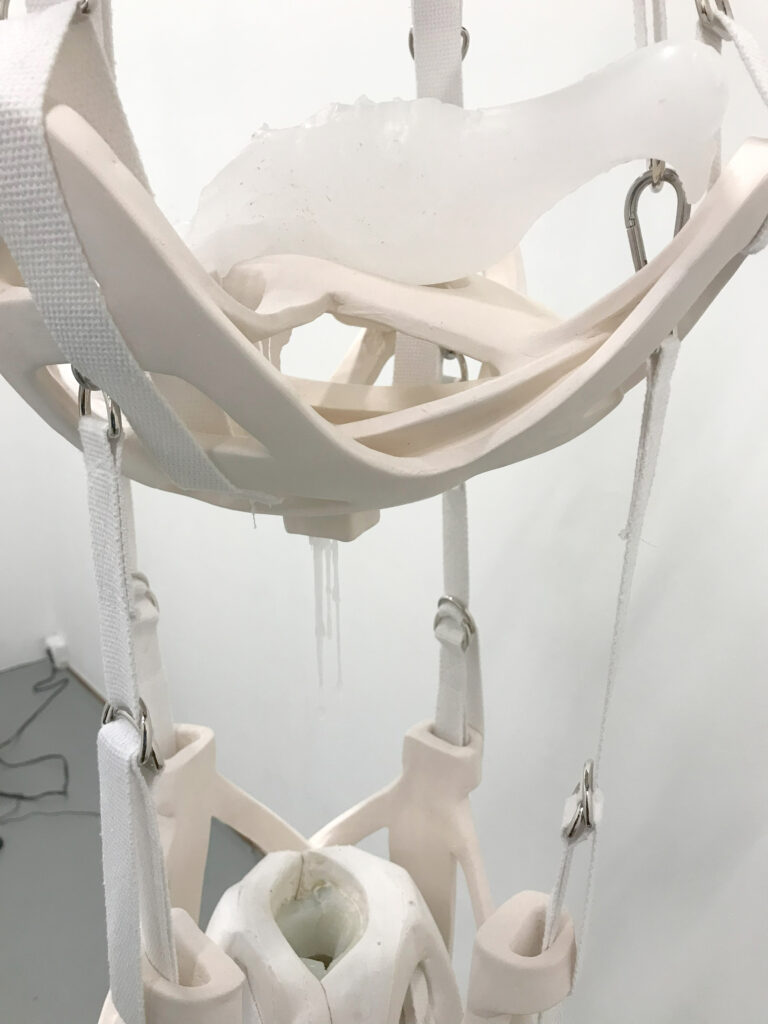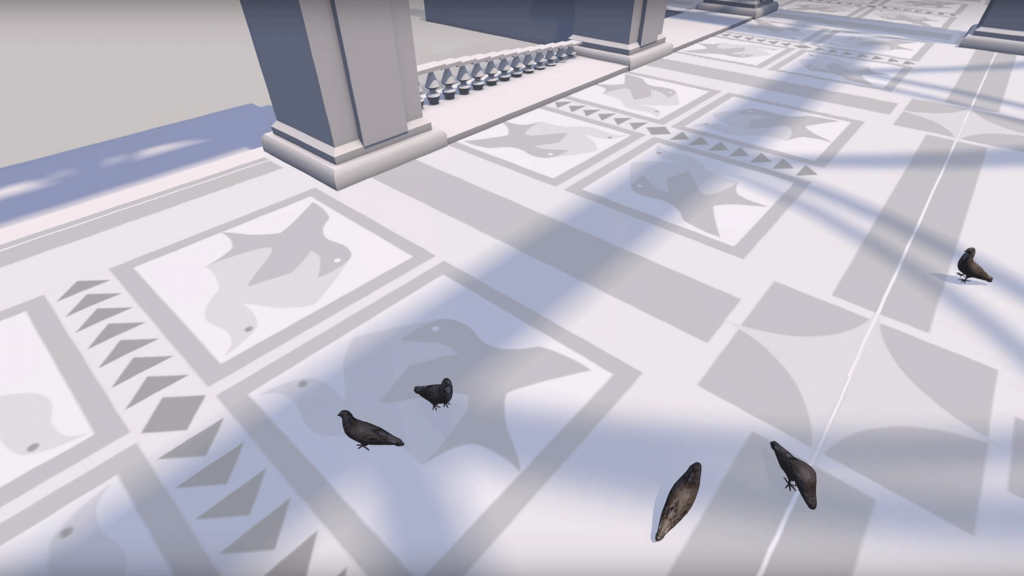My Heart is not a Clock



Excerpt from the exhibition text:
A space with a borrowed name from a time long ago exists in the present, on another continent. Buried and frozen in time, yet resurrected again and again another Pompei lies in Brooklyn. In a small physical space a virtual world expands. Destruction and rebirth repeat not without cost. Accelerated cycles are running dead in the end. History repeats itself. But life passes. Time is the sensation of memory.
Pompei is excited to present “My Heart is not a Clock” an installation of two ceramic sculptures and a virtual reality video by Johanna Strobel.The immersive video explores philosophical concepts of circular time and the loss of species through human caused extinction. Situated in a stylized version of the Villa Farnesina in Rome, the voiceover narration follows the example of the passenger pigeon’s extinction in the early 20th century and its possible future de-extinction through cloning throughout the circle of time.
The two hanging sculptures create a circular system. Both consist of multiple ceramic parts connected with straps and fasteners and contain infrared heating elements as well as a mold of a bird and egg respectively.
Together the sculptures function in a way like an hourglass: A wax bird is placed in the top part of the first sculpture. The heating element gradually melts the wax bird, causing it to drip into the lower part of the sculpture where an egg-shaped mold captures the wax. Once the wax egg is removed from the mold, it can be placed onto the sister sculpture and the process is reversed: the wax egg melts into a bird-shaped mold. With every iteration some of the wax evaporates, so that in the end just fragments of birds and eggs are cast and remelted until all the wax is gone – the cycle accelerates until it stops.




















15:10
After nearly half a decade, construction has finally been completed. Finalized with luscious frescoes sweeping across expansive ceilings, the Villa is a marvel for all those fortunate enough to visit. At the unveiling ceremony a confused guest asks patron Signore Agostino Chigi: “what will come of the barren trompe l’oeil pedestals lining the surrounding walls? What will the artisans render to fill these voids? The fresco surely cannot be complete.” Met with silence, the guest could only conclude that absence creates an insatiable desire, and that this very absence was the intended occupant of the cold, gray pedestals. Can desire expand beyond the confines of one’s lifespan? Concerned with gazing, both of the navel and of the stars, Signore Chigi had the Villa’s loggia decorated with an elegant astrological constellation displaying planetary positions as they were on November 29th, the patron’s date of birth. The planets have continued to orbit, and right now is the oldest the Earth and all of its inhabitants have ever been.18:45
Far beyond the fields on the perimeter of town, a low dark cloud is rolling swiftly across the horizon. As it approaches, a deafening cacophony can no longer be ignored. This is no cloud – the Passengers have returned en masse, their tesselating bodies shading the ground below like a total eclipse of the sun. Their hunger and sheer numbers have destroyed livelihoods, and their endless, mad search for sustenance and breeding grounds continue to torment local residents, many of whom have ultimately concluded that the species must be destroyed. A campaign to annihilate the Passengers has begun, and everyday citizens have taken to shooting aimlessly into the heavens.19:14
Martha was the lone Passenger still alive, an endling. Held in captivity for many years, Martha was unable to move much within her restricting cage or to socialize with her otherwise extinct kin. Perhaps these melancholic conditions affected her circulatory system, leading to her eventual death by stroke. Upon her death the taxidermists got to work, expertly preserving her flesh and sinew – Martha was a local celebrity, after all. A ceremony was held in her honor, and a memorial statue erected to commemorate and eternalize the Passengers for generations to come.20:22
Rising from the ashes, the Italian Renaissance villa slowly assembles itself, only to collapse into dust once more. Interlocking and swirling in unison, Passengers flock to the reincarnated site, only to disappear moments later. What do we choose to monumentalize as an individual, or as a society? Always remember that absence creates desire.
Time is typically understood as linear, yet our most ubiquitous visual representation of it – the circular three-handed clock – defies this very idea. The heart, another clock of sorts, will only beat so many times within a given lifespan. At birth, a slow and endless countdown begins. Martha’s clock ran out long ago, yet discussions of de-extinction procedures are currently underway. Scientists question if they can repurpose Martha’s dried and dusty skin to revive a new generation of Passengers, over 100 years after their extinction. A Frankensteinian phoenix of this sort has undeniably complex implications, ecological and otherwise, broad and unforeseen. Does Martha’s absence merit a desire for the unnatural regeneration of her kind? Reincarnation by human intervention is the act most akin to time travel that mankind is able to perform.– Moira Sims




